A baguette is a long, thin loaf with a golden, crisp crust and an airy interior. It’s an iconic French bread and there’s nothing like eating a warm, freshly baked baguette with a smear of butter. This French baguette recipe will show you how satisfying it is to bake fresh bread at home and how it’s well worth the effort.

This post contains affiliate links. As an Amazon Associate, I earn from qualifying purchases. Please read the disclosure.
Table of Contents
ℹ️ Introduction
With a crisp crust and an airy, chewy interior, the French baguette is one of the most popular artisan breads. A freshly baked baguette is something that can be eaten any time of day, and it goes with practically any type of cuisine!
I used to be pretty intimidated about baking fresh homemade bread, but through trial and error, I’ve become quite good at bread making, and now I do it every few days. So, if you’re nervous about trying it, know that you’re not alone and you have to start somewhere!
Mastering baguettes requires some time and effort, but you’ll be rewarded with oohs and aahs from your friends and family because they are going to love this recipe!
When you use this recipe, you’ll learn the techniques to make baguettes that are perfectly crisp and airy. Baking bread is such a rewarding experience and I hope you’ll try this recipe!
❤️ WHY THIS IS THE BEST BAGUETTE RECIPE
- Your friends and family will be so impressed with homemade baguettes like you get in French bakeries.
- You’ll get a crisp, golden crust, just like artisan French bread.
- The recipe is easy to follow, even for beginners. I include step-by-step instructions, photos, and a video, which is useful to learn how to shape the loaves.
- You only need five ingredients!
- This is a great recipe that gives consistent results because it includes weight measurements in metric and imperial.
- When you make authentic French baguettes at home, they have incomparable flavor and aroma. Far better than store-bought!
💡 Tips to Make French Baguettes at Home
There are some techniques that you need to follow to make perfect baguettes. Here are all my tips for mastering the art of baking French bread. If you have any further questions, comment below or visit the King Arthur Baking Company website. It has so much great information and many more tips!
- A good bread recipe starts with high-quality bread flour, which gives structure to the baguette dough. I use King Arthur flour, and I love the results. You can use bread flour from any company, including Bob’s Red Mill or Gold Medal.
- Bread recipes either use a sourdough starter or yeast to get the bread to rise. I prefer to use instant yeast.
- The baguette has pretty simple ingredients- bread flour, water, yeast, and salt. I like adding a little sugar to my recipe, but it’s not necessary.
- I always use a kitchen scale to weigh my ingredients, and I’ve provided the exact quantities I use every time for this bread recipe.
- The dough will be a bit wet and loose, allowing for the airiness and holes that characterize a rustic baguette. Try to avoid adding too much extra flour. I give you some techniques in the step-by-step instructions to make the dough more manageable without adding a lot of flour.
- I prefer to use a stand mixer because it makes kneading the sticky dough very easy.
- You can also knead by hand, but it is a bit messy. Start out using a wooden spoon to combine the ingredients, and switch to kneading by hand. Knead the dough well so that it develops the gluten.
- Use a silicone dough scraper to transfer the dough and scrape the mixing bowl.
- The bread dough needs to rise twice (this is called ‘proofing’). The first proof is in a container. The second proof is after the loaves are shaped.
- Place the dough in a large enough bowl to allow for expansion. I use a large plastic container with a lid. If you don’t have a bowl with a lid, cover a large bowl with plastic wrap that’s been sprayed with oil.
- How quickly the dough rises depends on the temperature of the surroundings. All timings that I’ve given assume that the dough is rising at room temperature.
- Allow the dough to proof until it has almost doubled in size.
- Don’t overproof the dough. This happens when you let the dough rise for too long. You’ll know your dough is over-proofed if, when you poke it, it doesn’t spring back to the touch. To fix this, press down on the dough to remove the air, then reshape and start the proofing process over again.
- Put the dough in the fridge if you need to go somewhere or slow down the proofing process. This makes the bread even better! Take the dough out of the fridge two hours before proceeding with the recipe, allowing it to come to room temperature and then continue rising. I frequently do this on busy days.
- When you’re shaping the baguettes, pinch and seal the seams well.
- Shaping the dough into a baguette shape takes a bit of practice. You may have a misshapen baguette when you make this recipe for the first time, but you’ll get better every time you make this bread.
- I like to use this perforated baguette pan. It’s so convenient!
- If you want an authentic long, thinner, baguette you can divide the dough into three pieces, and reduce the baking time.
- Allow the shaped baguettes to increase in size by about 1 ½ times.
- After the loaves have risen and right before baking, use a sharp, serrated knife to score or slash the top of the baguette loaves with diagonal cuts about 1⁄2 inch deep to create the classic baguette look. Scoring allows the dough to expand and prevents cracking.
- Spray or rub water over the loaves right before baking, for a crisp crust.
- Preheat the oven to the highest temperature. Mine can be set to a maximum of 500 degrees Fahrenheit (260 degrees Celsius). Place one rack on the lowest level with a heat-proof container. I use a metal cake pan that I reserve for this use. You can also use a cast iron pan.
- I start preheating about 20 to 30 minutes before baking, but I have an old oven!
- When you put in the loaves, you’ll pour hot water into this pan to create a steamy environment. Make sure you wear long sleeves and use gloves to protect against any splashes!
- Reduce the temperature to 425 degrees Fahrenheit (218 degrees Celsius) when you put the bread in. Baking at this temperature helps create a crisp, crackly crust.
- Check for doneness by measuring the internal temperature in the thickest part of the loaf with a digital thermometer. It should reach an internal temperature of 190 to 200 degrees Fahrenheit (88 to 93 degrees Celsius).
- I like to loosely cover the loaves with foil after the first 12 minutes, and the crust comes out golden brown. However, if you find that the loaves are not browning enough, you can omit this step or remove the foil early.
- Cool completely on a wire rack before cutting, to allow the crust to firm up.
- Store the cut baguettes in brown paper bags at room temperature to prevent drying.
- You can freeze fresh bread for up to 3 months. Thaw and reheat in the oven.
✅ Why Trust Neena at Paint the Kitchen Red?

Neena has been perfecting her recipes for over 25 years. The years of practice have honed her skills, resulting in consistently delicious and well-cooked meals. Her expertise enables her to provide valuable insights, troubleshooting advice, and innovative recipe ideas. Every recipe is tested multiple times, so you can be sure that it works the first time!
❓ FAQS
There are a few reasons why the dough isn’t rising:
– The water was too hot. Make sure the water is warm to the touch but not hot, no warmer than 105 degrees Fahrenheit (40 degrees Celsius).
– The yeast has expired. To test if your yeast is active, proof it in warm water before mixing the dough.
– The room is too cold. To rise, the dough needs a warm environment. Try placing it in the oven with a bowl of hot water.
– The dough is dried out. When the dough is rising, it needs to be covered or it can dry out. Cover the container loosely with plastic wrap that’s been coated with oil or use a lid.
If you use active dry yeast, add 25% more yeast and first dissolve it in warm water for a few minutes till it bubbles up. Add this mixture to the flour and reduce the quantity of water in the recipe by the amount of water used to hydrate the yeast.
You can use a couche (canvas baking cloth), or a large heavy kitchen towel that can be folded accordion-like to support the loaves. Place the cloth on a sheet pan and dust generously with flour. Place the baguette loaves on the cloth about 6 inches apart, and fold the cloth between the loaves upwards to create a wall between the loaves. Use a preheated baking stone or heavy-duty baking sheet to bake the loaves. To transfer the loaves to the oven, use a pizza peel.
Yes, you can make half the recipe by reducing all ingredients by half.
French Baguette Ingredients
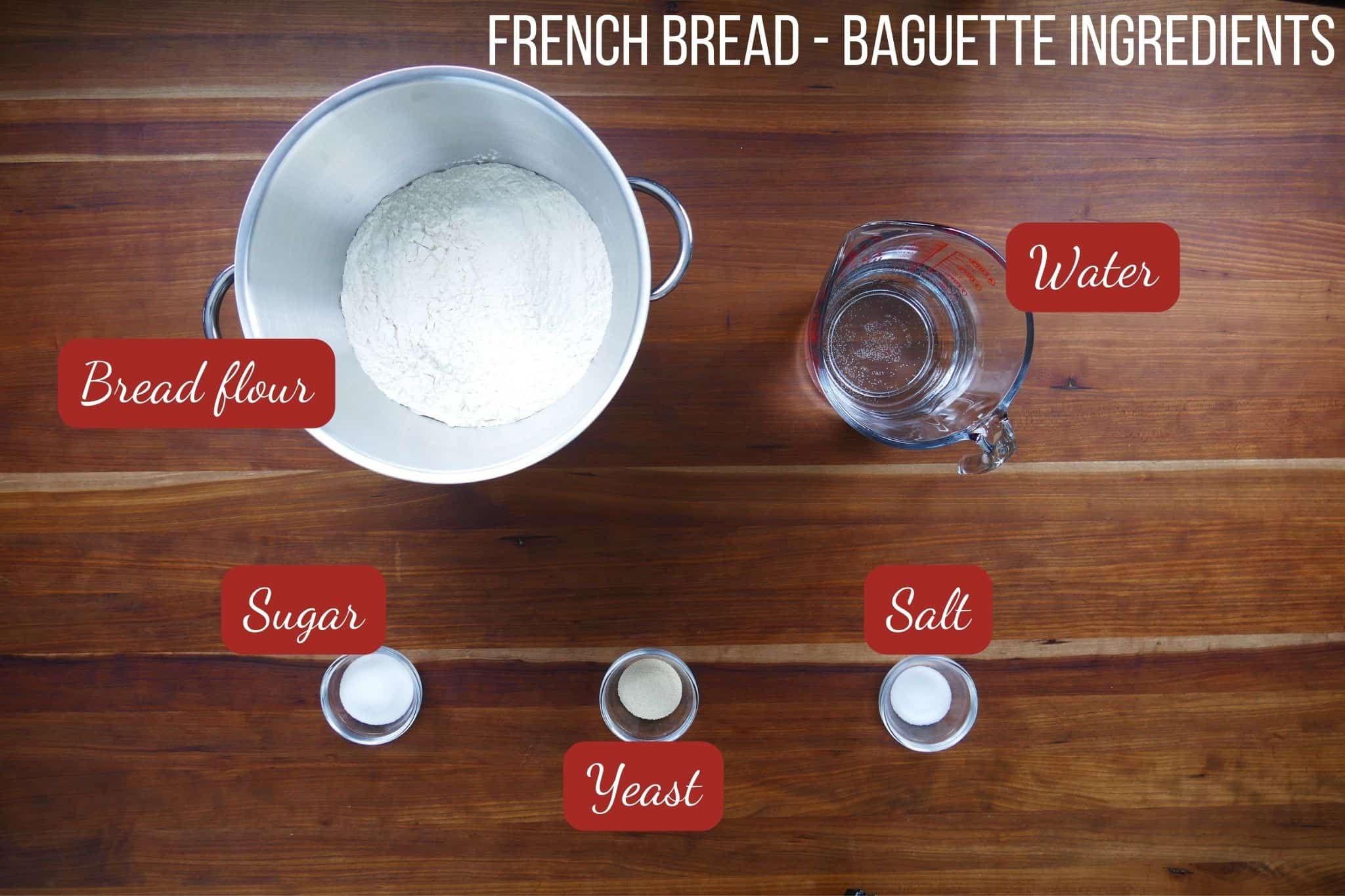
- Bread flour has a higher protein content, which creates more holes in the bread and a chewy texture. I like to use King Arthur brand bread flour which has a higher protein content than some other brands.
- Use lukewarm water (about 95° F to 100° F or 35° C to 38° C). The water will be at a temperature that you can comfortably put your hand in it. If it’s too hot, it can kill the yeast. If it’s too cold, the yeast will take longer to work.
- Sugar is optional. I like to add just a tad for flavor and to improve browning.
- Instant yeast is also called bread machine yeast or rapid-rise yeast.
- I use table salt for this recipe.
Quantities and details are provided in the recipe card at the bottom of this post
🥣 EQUIPMENT I USE FOR THIS RECIPE
- Stand mixer
- Kitchen scale
- Silicone dough scraper
- Large mixing bowl with lid
- Baguette pan
- Old cake pan or cast iron pan for creating steam in the oven
📝 How to Make French Bread
- Mix the dough
- Knead and let rise
- Divide the dough
- Shape the dough
- Proof the loaves
- Bake the bread
Mix the dough

- Add flour to the mixing bowl of a stand mixer.
- Add yeast, sugar, and salt, and stir with a spoon to mix.
- Add lukewarm water and mix using the dough hook on medium-low speed for five minutes. Let the dough rest for 10 minutes. Mix for another 5 minutes.
- The dough will be mostly smooth and tacky but not too sticky. If you need to, add more flour if the dough is just too wet and sticky.
Knead and let rise

- Lightly spray a large bowl with oil.
- Transfer the dough to the greased bowl.
- Stretch and fold the dough onto itself with wet or oiled hands.*
[If the dough is too sticky, cover the bowl, set a timer for 10 minutes, and repeat the same process two more times.] Again, we’re trying to avoid adding too much flour, and stretching and folding allows the dough to come together and become soft and supple. - Turn the dough over, seam side down, and shape into a round shape. Cover with a lid or lightly greased plastic wrap. The dough should rise until almost doubled (depending on the temperature, this can take 1 to 2 hours). You can also let it rise slowly in the fridge. If you do this, bring the dough to room temperature (about 1 to 2 hours before proceeding with the recipe.)
* Reach under the front side of the dough, stretch the dough towards you, and fold it back onto the top of the dough. Repeat this from the back and each side. Watch the video in the recipe card for more help.
Divide the dough

- The dough should almost double in size.
- Turn the dough onto a floured surface.
- Try to avoid deflating the dough while you handle it.
- Cut the dough in half using a dough scraper. I usually weigh the pieces to make sure they are equal in size.
Shape the dough

- Working with one piece at a time, gently pat the dough into a 5×8 rectangle, with the long side facing you. Fold the dough letter style: pick up the right side of the dough and fold a third of the way over.
- Fold the left side of the dough over the first fold, like you would fold a letter.
- Take the edge of the dough furthest away from you (the top edge) and roll the dough towards you, pinching the dough onto itself as you roll, to make it a tight roll. The dough will be a thick log shape. Pinch the seams to seal and create a smooth log.
- Gently shape the log into a baguette shape. My baguette pan is about 16 inches long, so I make the loaves about 13 to 14 inches long.
Proof the loaves

- Carefully transfer the shaped loaf onto the baguette pan or proofing cloth (couche).
- Cover the pan loosely with a greased plastic wrap and allow the loaves to proof until they’re about 1 ½ times their original size (about 1 ½ hours) at room temperature. Remove the plastic wrap 10 minutes before baking.
- Right before putting the baguettes in the oven, use a sharp serrated knife to create ½ inch-deep diagonal cuts across the loaf. Slide the knife at a sideways angle, and not straight down, to create these slits.
- Just before putting the loaves in the oven, spray the loaves with a thin layer of water. Sometimes, I use my fingertips to moisten the loaves.
Bake the bread

- Preheat the oven to 500 degrees Fahrenheit (260 degrees Celsius) with an old cake pan in the middle of the lowest rack. Preheating can take some time, so plan accordingly.
- Once the oven is hot, open the door, slide the baguette pan onto the middle rack, and using an oven mitt, pull out the lower rack with the cake pan. Pour one cup of hot water into the preheated cake pan, slide the rack with the pan of water back into place, and close the oven door. Lower the oven temperature to 425 degrees Fahrenheit (218 degrees Celsius). Bake the bread for 32 minutes.
- After 12 minutes, rotate the baking pan 180 degrees, and loosely cover the bread with aluminum foil.
- Measure the internal temperature of the bread. It’s perfect at 190 degrees Fahrenheit (88 degrees Celsius). Cool the bread completely on a wire rack before slicing.
Recipes that go with French bread
- Cajun chicken pasta is a cross between Cajun jambalaya and tomato cream penne pasta and this bread would be great for mopping up all the sauce left in the bowl!
- Try making this air fryer salmon with blackened seasoning. Serve it with an arugula beet salad and this baguette recipe.
- Instant Pot coq au vin is a French chicken stew that’s hearty and comforting. Perfect with some crusty French bread.
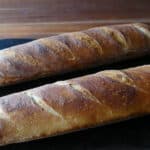
Fresh Homemade French Baguette Recipe
Equipment
Ingredients
- 5 ⅓ cups bread flour 24 ounces (680 grams)
- 2 tablespoon granulated sugar 1 ounce (28.5 grams)
- 2 teaspoon salt .5 ounce (14 grams)
- 2 ¼ teaspoon instant yeast .25 ounce (7 grams)
- 2 cups water 16 ounces (454 grams), lukewarm (about 100°F or 38°C)
Instructions
- Combine bread flour, sugar, salt, and instant yeast in the bowl of a stand mixer. [See note 1]. Add the water and mix, using the dough hook, on the medium-low setting for 5 minutes. Let the dough rest for 10 minutes, and mix again for another 5 minutes.
- Using a dough scraper, transfer the dough to a greased large container. [See note 2]
- Stretch and fold the dough onto itself with wet or oiled hands [See note 3]. Cover with a lid or lightly greased plastic wrap.
- Let the dough rise until almost doubled (about 1 to 2 hours). [See note 4]
- Turn the dough onto a floured surface. Avoid deflating the dough while you handle it. Cut the dough in half using a dough scraper. I like to weigh the portions to make sure they are equal in size.
- Working with one piece at a time, gently pat the dough into a 5×8 in. (13×20 cm.) rectangle, with the long side facing you. Fold the dough letter style: pick up the right side of the dough and fold a third of the way over. Fold the left side of the dough over the first fold, like you would fold a letter.
- Take the edge of the dough furthest away from you (the top edge) and roll the dough towards you, pinching the dough onto itself as you roll, to make it a tight roll. The dough will be a thick log shape. Pinch the seams to seal and create a smooth log.
- Gently shape the log into a baguette shape. My baguette pan is about 16 inches long, so I make the loaves about 13 to 14 in. (33 to 35 cm.) long.
- Carefully transfer the loaves to the baguette pan. Cover the pan loosely with a greased plastic wrap and allow the loaves to rise until they’re about 1 ½ times their original size (about 1 ½ hours) at room temperature.
- Place one rack in the lowest row of the oven and another rack in the middle row. Place an old cake pan in the middle of the lowest rack. Preheat the oven to 500 degrees Fahrenheit (260 degrees Celsius) or as hot as your oven will go. [See note 5]
- Remove the plastic wrap from the loaves 10 minutes before baking. Before putting the baguettes in the oven, use a sharp serrated knife to create ½ inch-deep diagonal cuts across the loaf. Slide the knife at a sideways angle, and not straight down, to create these slits.
- Just before putting the loaves in the oven, spray the loaves with a thin layer of water, or use clean hands to rub some water onto the loaves without deflating them.
- Once the oven is hot, open the door, slide the baguette pan onto the middle rack, and using an oven mitt, pull out the lower rack that has the cake pan. Pour one cup of hot water into the cake pan, slide the rack back in, and close the oven door. Wear long sleeves and use oven mitts to avoid being scalded.
- Lower the oven temperature to 425 degrees Fahrenheit (218 degrees Celsius). Bake the bread for 32 minutes. [See note 6]
- After 12 minutes, rotate the baking pan 180 degrees, and loosely cover the bread with aluminum foil and continue baking.
- Measure the internal temperature of the bread. It’s perfect at 190 degrees Fahrenheit (88 degrees Celsius). Cool the bread completely on a wire rack before slicing.
Notes
- Note 1: Use a kitchen scale to measure ingredients for best results.
- Note 2: I use a plastic bowl with a lid, but you can cover your bowl with greased plastic wrap if you don’t have a lid.
- Note 3: To stretch and fold, reach under the front side of the dough, stretch the dough towards you, and fold it back onto the top of the dough. Repeat this from the back and each side. Watch the video in the recipe card for more help.
- Note 4: The time it takes for the dough to rise will depend on the surrounding temperature. You can also let the dough rise slowly in the fridge. If you do this, bring the dough to room temperature before proceeding with the recipe.
- Note 5: In a later step, you will add hot water to the pan to create a steamy environment in the oven. Preheating the oven to a high temperature can take some time, so plan accordingly.
- Note 6: The timings can vary based on how hot your oven runs. Use a digital thermometer to measure the internal temperature of the bread.
- Baking bread requires a few techniques for success. See the blog post for more detailed recipe tips.
Nutrition
Thank you for visiting Paint the Kitchen Red. All photos and content are copyright protected. Please don’t use any content without prior written permission. If you’ve made this recipe and would like to share it with your friends, please link back to this recipe. Thank you!
I am not a certified nutritionist. I provide my best estimate of nutritional information merely as a courtesy to my readers. If you depend on nutritional information for dietary or health reasons, I suggest using your favorite online nutrition calculator to confirm the nutritional value of this recipe based on the actual ingredients that you use.
Did you know that the best way to support your favorite bloggers is to comment and rate recipes, and share on social media? If you loved this recipe, please comment and give it a five ⭐ rating in the comment section below. If you’re a pinner, pin this post using the Pin buttons at the top and bottom of this post and in the recipe card above. Thank you for your support!
Recipes that Can Be Served with French Bread
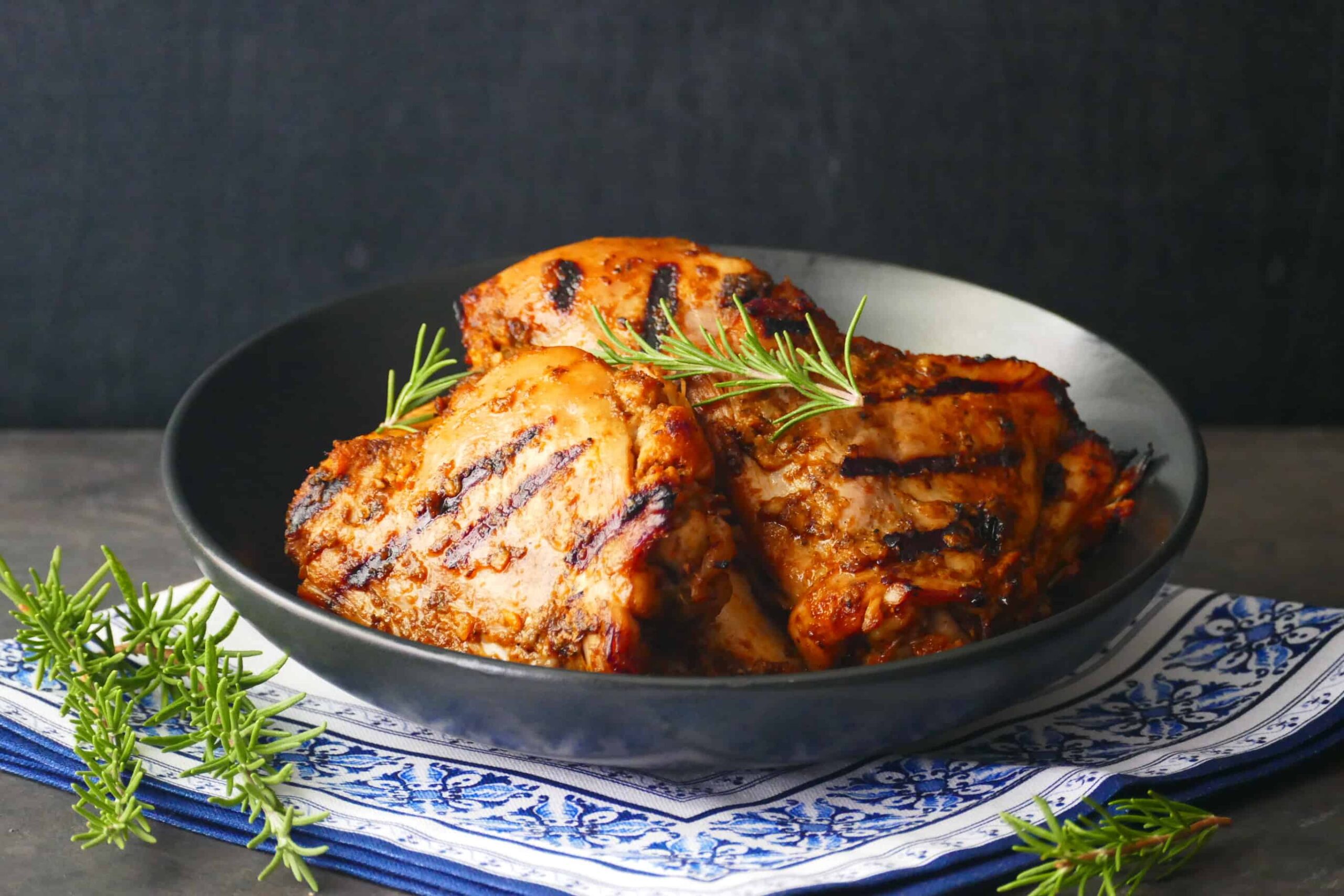
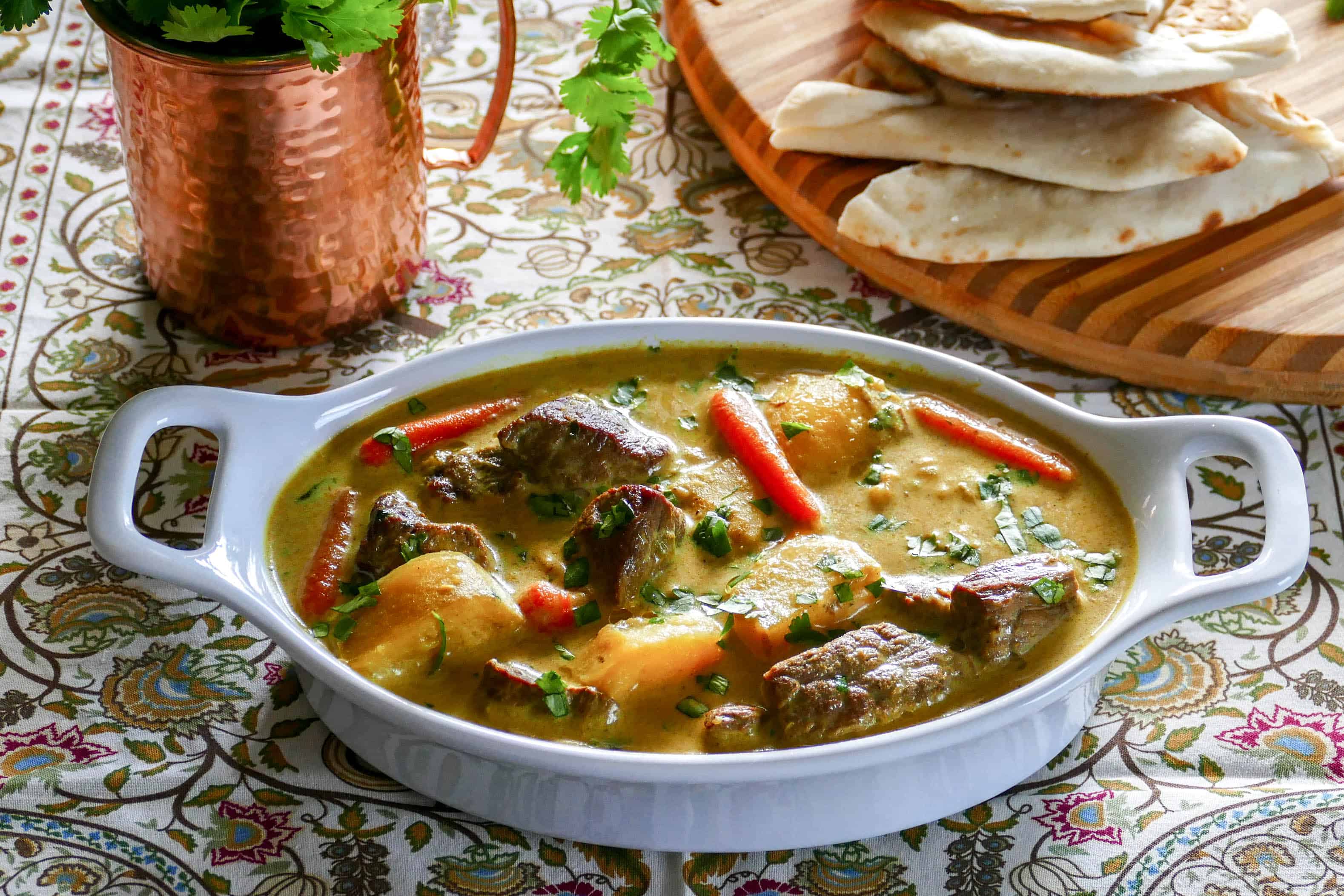
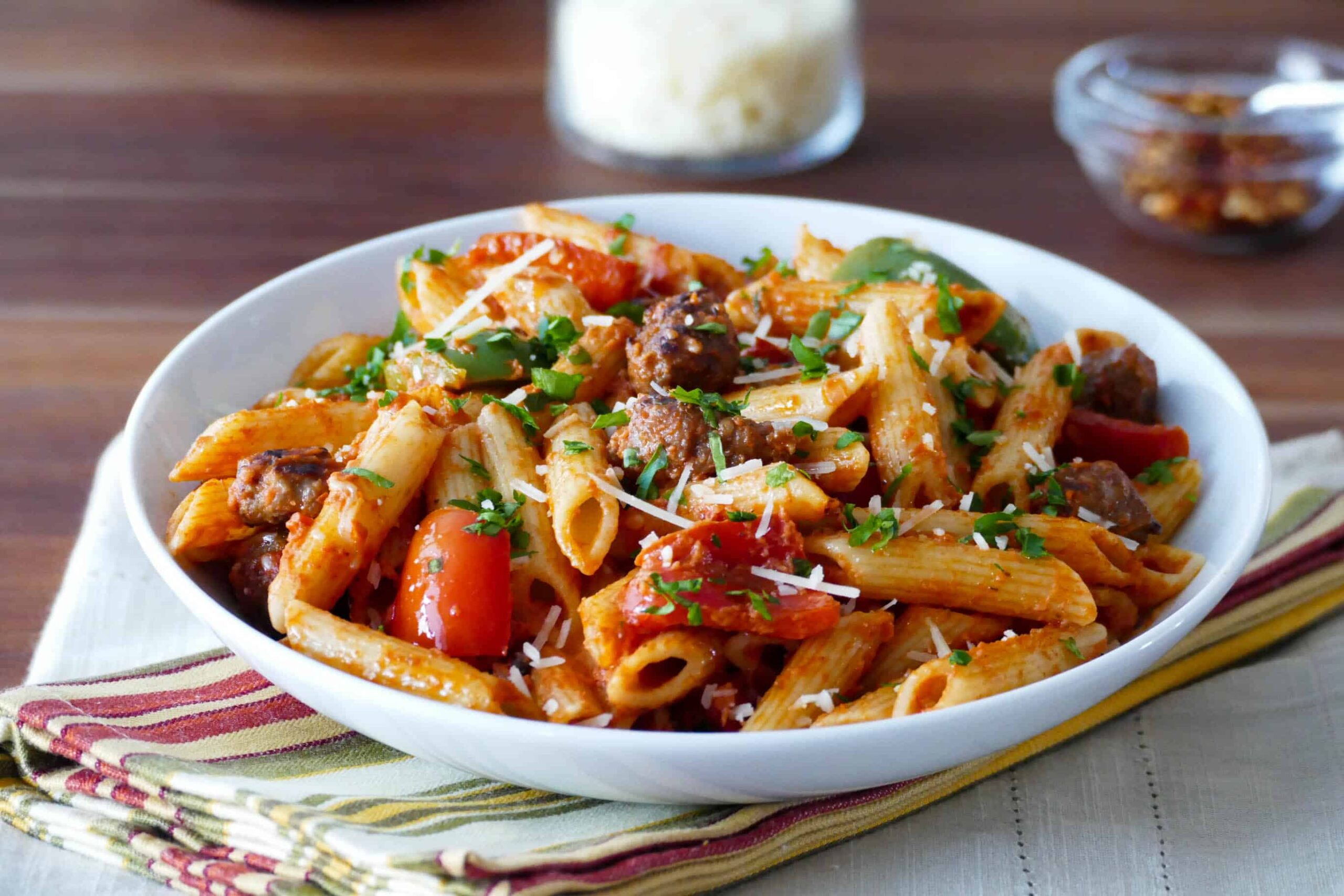









Purr McEwen
This bread is wonderful and the recipe is easy to follow!
Neena Panicker
Purr, thank you for taking the time to comment! I’m so glad you liked the French baguette recipe and it came out well.